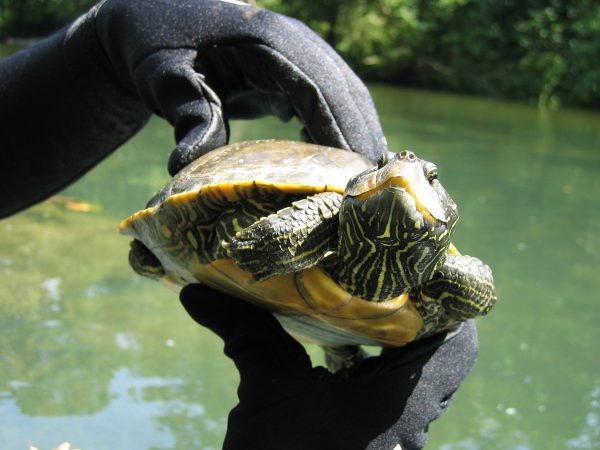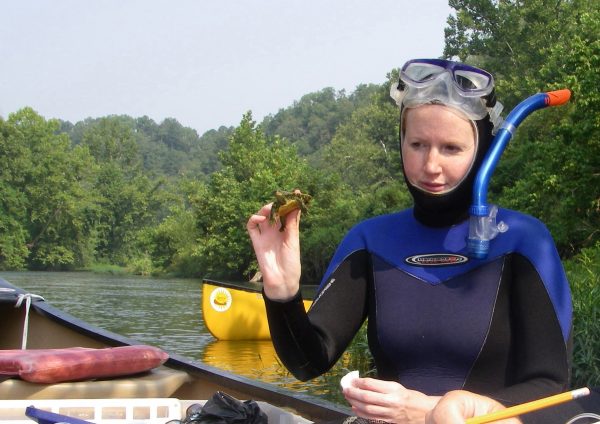When it comes to conservation efforts, the biggest, cutest and most recognizable animals are often the first to gain public attention. From cuddly koalas to giant, gentle manatees, the beasts at the top of the food chain usually become symbols for hope in the threatened animal kingdom.

Florida Museum photo by Amber Pitt
But the smaller critters often overlooked are also essential parts of the planet’s ecology.
River turtles, which Floridians may glimpse basking on riverbanks, help ecosystems function by cycling nutrients and maintaining food web dynamics.
“The importance of river turtles is really underplayed,” said Amber Pitt, a Clemson University postdoctoral research fellow who studied with Florida Museum of Natural History herpetology curator Max Nickerson as a University of Florida graduate student. “River turtles are long-lived, rely on the same water resources that we do and can serve as indicators of water quality. People should be concerned if turtles are impacted by poor water quality because we are likely being affected, too.”
In a Florida Museum study published Sept. 14, 2012, in Volume 3 of Copeia, co-authors Pitt and Nickerson found harvesting may have detrimental effects on river turtle populations for decades. In Missouri, a population of northern map turtles has not rebounded since it was harvested in the 1970s.
Researchers used data collected by Nickerson in 1969 and 1980 as a baseline, then surveyed the same stretch of river in the Ozarks in 2004 to determine northern map turtles had not recovered from a previous 50 percent population loss caused by harvesting. Assessment of the northern map turtle, a protected species in some states, is essential as increasing human populations and global warming further alter its habitat.
Inhabiting river systems from southern Arkansas to Quebec, the northern map turtle, Graptemys geographica, is among the most wide-ranging map turtles in the U.S. They are dietary specialists and depend mainly on snails, making the species especially susceptible to biodegradation. Formally known as the common map turtle due to its wide geographic distribution, its name was changed in 2000 so people would not assume it was abundant, Pitt said. The northern map turtle is listed in Appendix III of the Convention on International Trade in Endangered Species of Wild Fauna and Flora and this research may be used as a guideline for conservation or protection of other turtle species.

Photo by Jeff Briggler
“Turtles are declining globally, but we really don’t know to what extent because we don’t have the data, and that’s one of the reasons this information from the ‘60s is so valuable,” Pitt said. “It’s a big problem for turtle conservation – so many populations seem to be declining, but the long-term datasets needed to evaluate these trends are rare, largely due to time and funding constraints associated with conducting field studies.”
Scientists determined harvesting was likely for food based on analysis of records published by Nickerson and Pitt in the Florida Museum of Natural History Bulletin in August 2012. Data showed there were fewer adult females, which are larger than males and preferred for the food trade. Local residents also confirmed turtle harvesting occurred in the river, Nickerson said.
“This shows that harvesting, even if it’s a one-time event, can cause a turtle population to significantly decline and remain impacted for decades, because this species doesn’t reproduce quickly,” Pitt said. “It was really discouraging to see that even without the pressure of further harvesting, they couldn’t recover over that long time period, which is partially due to their biology but may also be associated with habitat degradation and disturbance.”
Researchers surveyed the nearly 3-mile stretch of the North Fork of the White River in Ozark County, Missouri, in 2004 by snorkeling to locate, tag and record information about the turtles. The survey showed habitat degradation due to increased siltation, sedimentation and algal blooms.
“What’s happening in these big spring-fed rivers is very important,” Nickerson said. “When you clear the banks of a river, you increase siltation, which affects the food sources, reproduction, plant growth, species composition and basic ecology of that section of the stream, and perhaps the entire river.”
River degradation has been partially caused by human recreation, which drastically increased by 2004, Nickerson said. People swimming and boating also frighten turtles so they may not bask as much as needed to maintain health and maximize egg production.

Florida Museum photo by Kristen Grace
“You might not really think about the impact of jumping into the river,” Pitt said. “This is an area that’s very beautiful and a lot of people go swimming and canoeing there. The turtles jump into the water when humans come, so they’re not getting as much time for thermoregulation as they need to maintain their physiological processes and health.”
Although scientists generally agree many turtle populations are declining worldwide, little has been published on river turtle communities, said Don Moll, a professor emeritus at Missouri State University who co-authored a textbook on freshwater turtles.
“This is a very important study because it follows the dynamics of this turtle community over a more than 30-year time period, and really it’s the only published river turtle study I can think of that does that,” Moll said. “It’s a real contribution in that sense – it’s so unique.”
Despite their small size – adult female northern map turtles are about 11 inches long – Pitt said she hopes river turtles will benefit from conservation efforts.
“Often times with conservation, you have the charismatic mega fauna that people care about, such as sea turtles – everybody cares about sea turtles, including me,” Pitt said. “But river turtles are facing just as many threats as sea turtles. People are also harvesting river turtles and there are very few laws in place to stop this harvest – it’s a global epidemic that is causing turtle populations to be wiped out.”
Learn more about the Herpetology Collection at the Florida Museum.